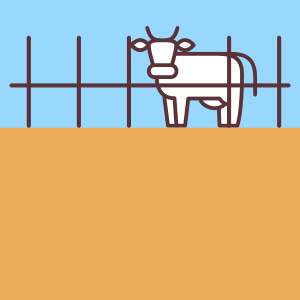As mentioned above, fencing could be done for permanent or temporary use. The two types are being discussed below. Furthermore, depending on the material used for the fencing, some of the required materials below would be either included or excluded from what is necessary.
Materials required for Permanent Fencing
- Fencing material (such as fence posts of wood, and wire or mesh).
- Hardware including hinges, screws, and nails to assemble the enclosure.
- Heavy-duty gloves for protection and ease of handling of equipment and fencing materials.
- Tools such as an a-level, tape measure, drill, hammer, shovel, fence pliers, and saw, etc.
- A post hole digger/post stomper.
- Wire strainers for tightening the fence.
- A crowbar or another tamping tool for breaking up soil when digging.
- Barbed wire.
- Seeds.
- Hardware such as hinges and nails.
- Tools such as a level, a tape measure, a drill, hammer, shovel, fence pliers, saw, etc.
Materials required for Temporary Fencing:
- Temporary fencing wire (usually electric polywire or polytape).
- Fence posts (plastic or fibreglass step-in post; metal ‘t’ posts).
- Reel for creating temporary fence wire.
- Electric fence charger.
Steps of implementation:
- Plan the fence layout for the enclosure: Consider the area that is to be enclosed. How large will this area be? Where will gates and corner posts be placed? Try to avoid hard, rocky soils and slopes as these can make installation difficult and threaten the long-term structure of the fence line. It is also advisable to mark out the line of the fence with a piece of wire, string, or paint before installation. Keep in mind that straight lines are most cost-efficient as every corner requires a corner-post. The most important elements to map-out are fence lines, corners, and gates.
- Choose the fence material: Fence material and fencing types vary in terms of their durability, ease of installation, and costs. Different types of fencing are thus fit for different purposes and objectives. Keep in mind that the specifications of the fencing you will implement will vary based on the objective of the enclosure being constructed. For example, fencing aimed at enclosing cattle to prevent them from grazing on a recovering area of land will require a taller fence with fewer horizontal lines than a fence aimed at restricting the movement of sheep. For an overview of the different types of fencing and a comparison between them, you can check out this website. Different fence materials and fencing types are suitable based on the objectives you want to achieve through using enclosures or exclosures.
- Installation of the fence: This process will vary based on the type of fencing chosen and resources available.
3.1 Installation of a wooden fence: In the case of wooden posts in clayey soils, posts should be placed at a depth around ten times the diameter of the posts. The basic steps for installing a woven-wire permanent fence are the following:
- Start by installing corner posts. These posts should be set securely into the ground and should be braced with wooden supports. Braces ensure that tension can be absorbed by the fence. You can read more about different types of bracing for corner posts here.For temporary fencing, plastic step-in posts are most commonly used and make for easier installation/retrieval.
- Install the line posts. These posts should be placed every 8-12 feet along the fence line. Make sure they are set securely and that they are straight by using an a-level.
- Unroll the woven wire fence (or other fencing material) along the side of the fence against which you want to secure it. Stand the fencing material up and attach it to one of the corner posts, using fencing pliers and/or staples. Make sure the fence is taut and straight. For temporary fencing, a reel is needed to unravel the fencing material. Stapling the fencing material onto the posts and tightening of the wire is usually not necessary with temporary fencing as posts come with slots where the fence wire can be attached or threaded through.
- Attach the fence to each line post, pulling it tight with fencing pliers or a come-along tool
- Staple the fence to the line posts using fencing staples. Make sure to staple the fence securely to each post.
- Install any gates or other features you need. Make sure to install these securely.
- Walk the line of the fence and double check that your fence is properly installed. If installing electrified temporary fencing, a fence charger should be bought and installed, too.
Materials required:
- Barbed wire
- Seeds
- Hardware such as hinges and nails
- Tools such as a level, tape measure, drill, hammer, shovel, fence pliers, saw, etc.
- Electric fence charger
- Optional: Electric fence tester.
- Optional:Quad/Tractor.
Stages of implementation:
3.2 Installation of a living fence: There are several ways of building a living (or ‘live’) fence, depending on what vegetation is available as well as on the local environmental context. The basic methodology is the following:
- Choose the right species for your living fence. Select plants that are native to your area and are suitable for the growing conditions and fencing needs on your land. Some popular species for living fences include holly, boxwood, willow, and bamboo. Consider the size of the fence you want to build (width of posts, height of fence, etc.) as well as the growth time of different species. Using crop trees for live fencing can be an effective solution too.
- Prepare the soil. Clear the area of any debris and weeds. If necessary, loosen the soil along the line of the soon-to-be-built fence and mix in compost/fertiliser if you believe the soil might not be nutrient-rich enough
- Plant the shrubs/sow the seeds. Follow the instructions for tree planting and plant the seeds or stems at an appropriate distance from each other (this will vary depending on selected species and size of the tree at full maturity, as well as the technical considerations for the fence).
- Note: When fencing for enclosures, it is likely that the initial trees planted will merely act as fence posts and that an additional, horizontal reinforcement will need to be planted once these trees have grown. As such, as long as a minimum spacing between stems/seeds is observed, the next biggest consideration for spacing is likely to be the materials used for this later horizontal reinforcement (see step 5).
- Apply water and mulch. Water the shrubs regularly during the first year to help them establish their roots. Spread a layer of mulch or compost around the base of the plants to retain moisture and suppress weed growth.
- Prune and maintain the shrubs and trees. Trim the shrubs as needed to maintain their shape and size. Remove any dead or diseased branches promptly.
- Create horizontal reinforcements. Once the planted trees have reached a good height (usually between 1 and 2 years after sowing), use material such as tree cuttings, bamboo, and barbed wire to form the horizontal layers of the fence. Fix the bamboo and/or wire to the trees - the fence posts - using vines or cloth. This case-study uses an arrangement of 1 strand of barbed wire with 2 bamboo sticks above and below it.
This intervention contributes to:


Estimated costs and benefits of different variations of this intervention:
| Category |
Permanent fencing
(¼ mile or 402m) |
Flexible fencing
(¼ mile or 402m) |
Live fencing
(¼ mile or 402m) |
| Location |
Iowa, US |
Iowa, US |
Khmer, Cambodia |
| Type |
High-tensile electrified wire fence |
Electrified polywire fence |
Cashew living fence |
| Labor time |
18 hours |
2 hours |
17.5 hours |
| Purchasing costs |
USD 1,172 |
USD 315 |
USD 206 |
| Source |
ISU, 2022 |
ISU, 2022 |
WOCAT, 2019 |
1. Cashew Living Fence in Cambodia
Description
Cashew living fences, reinforced with bamboo and/or barbed wire, are a vital intervention in Kampong Chhnang, Cambodia, particularly in Krang Liav and Rolea Pha-er. These living fences serve the dual purpose of confining or excluding cattle from gardens or rice seedbeds and yielding valuable products. Fast-growing cashew trees act as fence posts, supplemented by bamboo poles and barbed wire. They not only control cattle movement but also offer nuts, fruits, and fuelwood. Cashew seeds are sown alongside the fence on a small berm, with spacing determined by the farmer's objectives. Within a year, the trees grow tall enough to support bamboo and wire. The environmental context of this intervention includes flat terrain, a tropical climate with distinct wet and dry seasons, and sandy or loamy soils with low fertility. Deforestation and high groundwater levels further characterize the region. Despite its benefits, farmers face challenges such as erratic rainfall, temperature increases, recurrent droughts, and labour shortages due to migration and historical disruptions. NGOs are actively involved in rebuilding agricultural knowledge in the area. Approximately 15 farmers in Krang Liav are benefiting from cashew living fences, addressing cattle grazing issues and providing additional income and resources from cashew products.
2. Living fences for protecting crops and plants in Burkina Faso
Description
In Burkina Faso, deforestation and soil erosion are major issues, with reforestation efforts often thwarted by cattle grazing. To combat this, researchers have developed live fences as a cost-effective solution to protect crops and young plants. Live fences use species like Acacia and Bauhinia, chosen for their fast growth, low branching, and dense coverage. They're planted in trenches to aid root growth and require minimal upkeep, including weeding and pruning. Initially, digging trenches and obtaining enough plants posed challenges. To address this, researchers explored direct seeding methods, which proved successful with certain species like Acacia and Bauhinia. Overall, live fences have gained popularity among farmers, especially those growing vegetables. They offer a practical way to enhance reforestation efforts and improve conditions for crop farming in Burkina Faso.
3. Improvement of degraded pasture land with electric fence in Kasristskali, Georgia
Description
The pilot project in Kasristskali, Georgia takes degraded pastureland with the aim of regeneration by introducing a fencing, mowing and grazing regime that favours the growth of forage plants instead of weeds and where necessary reseeding forage plants. This showcase is part of the project "Applying Landscape and Sustainable Land Management (L-SLM) for mitigating land degradation and contributing to poverty reduction in rural areas", implemented by the Regional Environmental Center for the Caucasus (REC C) (WOCAT, 2020). It is community pastureland, which was abandoned and not maintained for many years (WOCAT, 2020). The site had been dominated by thistles and weeds before the intervention took place and was not suitable for grazing (WOCAT, 2020). The local community farmers were involved in all activities (WOCAT, 2020).
4. Portable fencing for rotational grazing in Texas, the US
Description
Rotational grazing can be efficiently managed with portable fencing, offering flexibility and cost-effectiveness. Stockmen often create permanent paddocks using traditional or electric fencing and then use portable options like poly wire to divide them further. This allows for frequent movement of cattle, promoting strip or mob grazing. Portable fencing typically involves using high-tensile wires, with some ranchers utilizing just two wires for basic infrastructure. Temporary electric fences are also popular, especially in narrow pastures where frequent movement is feasible. These fences are quick to set up and move, often requiring minimal time and effort. Innovative grazers like Jim Gerrish emphasize efficiency in fence moving. They use poly wire and step-in posts, laying out strips of pasture for rotational grazing. Gerrish's system involves moving cattle daily or even twice daily, with each move requiring only 20 to 25 minutes. His son, Ian, further emphasizes the durability and ease of handling of braided poly wire, often using metal posts for added stability. Overall, portable fencing offers a practical solution for rotational grazing, allowing for efficient pasture management and optimal utilization of resources.
5. Rehabilitation of pasture land through fencing in Tajikistan
Description
The approach involves demonstrating the benefits of rotational grazing through fencing off certain pasture areas for rehabilitation. In Tajikistan's Rasht Valley, a community fenced off a one-hectare plot for comparison with an adjacent open field that was routinely grazed. The fenced area showed faster rehabilitation and increased productivity, serving as fodder collection during the winter. By organizing field days, farmers learned about sustainable pasture management and applied rotation techniques. While social norms support sustainable resource use, access to financial resources for fencing can be challenging, and manpower shortages due to youth migration hinder implementation. Overall, the approach showcases the effectiveness of rotational grazing and encourages community ownership of pastureland for sustainable management.


